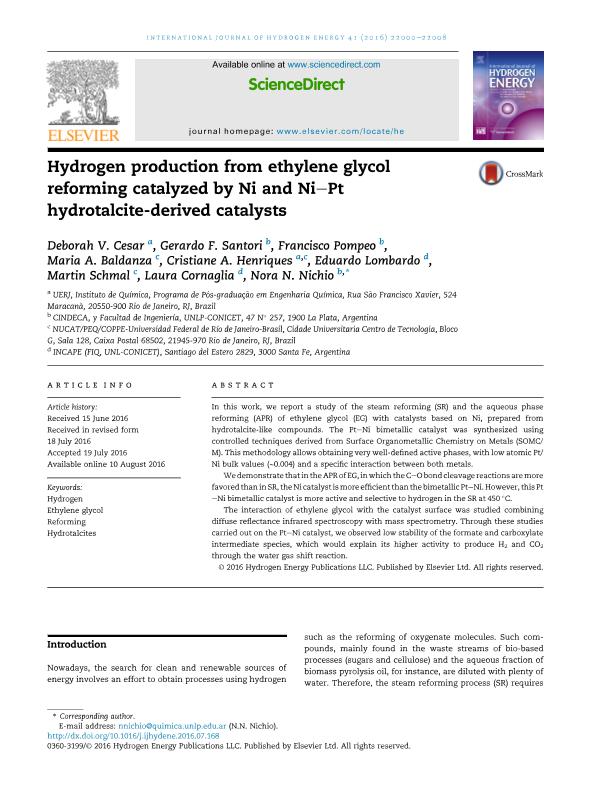Artículo
Hydrogen production from ethylene glycol reforming catalyzed by Ni and Ni–Pt hydrotalcite-derived catalysts
Cesar, Deborah V.; Santori, Gerardo Fabian ; Pompeo, Francisco
; Pompeo, Francisco ; Baldanza, Maria A. S.; Henriques, Cristiane A.; Lombardo, Eduardo Agustin
; Baldanza, Maria A. S.; Henriques, Cristiane A.; Lombardo, Eduardo Agustin ; Schmal, Martin; Cornaglia, Laura Maria
; Schmal, Martin; Cornaglia, Laura Maria ; Nichio, Nora Nancy
; Nichio, Nora Nancy
 ; Pompeo, Francisco
; Pompeo, Francisco ; Baldanza, Maria A. S.; Henriques, Cristiane A.; Lombardo, Eduardo Agustin
; Baldanza, Maria A. S.; Henriques, Cristiane A.; Lombardo, Eduardo Agustin ; Schmal, Martin; Cornaglia, Laura Maria
; Schmal, Martin; Cornaglia, Laura Maria ; Nichio, Nora Nancy
; Nichio, Nora Nancy
Fecha de publicación:
12/2016
Editorial:
Elsevier
Revista:
International Journal of Hydrogen Energy
ISSN:
0360-3199
Idioma:
Inglés
Tipo de recurso:
Artículo publicado
Clasificación temática:
Resumen
In this work, we report a study of the steam reforming (SR) and the aqueous phase reforming (APR) of ethylene glycol (EG) with catalysts based on Ni, prepared from hydrotalcite-like compounds. The Pt–Ni bimetallic catalyst was synthesized using controlled techniques derived from Surface Organometallic Chemistry on Metals (SOMC/M). This methodology allows obtaining very well-defined active phases, with low atomic Pt/Ni bulk values (∼0.004) and a specific interaction between both metals. We demonstrate that in the APR of EG, in which the CO bond cleavage reactions are more favored than in SR, the Ni catalyst is more efficient than the bimetallic Pt–Ni. However, this Pt–Ni bimetallic catalyst is more active and selective to hydrogen in the SR at 450 °C. The interaction of ethylene glycol with the catalyst surface was studied combining diffuse reflectance infrared spectroscopy with mass spectrometry. Through these studies carried out on the Pt–Ni catalyst, we observed low stability of the formate and carboxylate intermediate species, which would explain its higher activity to produce H2 and CO2 through the water gas shift reaction.
Palabras clave:
Ethylene Glycol
,
Hydrogen
,
Hydrotalcites
,
Reforming
Archivos asociados
Licencia
Identificadores
Colecciones
Articulos(CINDECA)
Articulos de CENTRO DE INV EN CS.APLICADAS "DR.JORGE J.RONCO"
Articulos de CENTRO DE INV EN CS.APLICADAS "DR.JORGE J.RONCO"
Articulos(INCAPE)
Articulos de INST.DE INVEST.EN CATALISIS Y PETROQUIMICA "ING. JOSE MIGUEL PARERA"
Articulos de INST.DE INVEST.EN CATALISIS Y PETROQUIMICA "ING. JOSE MIGUEL PARERA"
Citación
Cesar, Deborah V.; Santori, Gerardo Fabian; Pompeo, Francisco; Baldanza, Maria A. S.; Henriques, Cristiane A.; et al.; Hydrogen production from ethylene glycol reforming catalyzed by Ni and Ni–Pt hydrotalcite-derived catalysts; Elsevier; International Journal of Hydrogen Energy; 41; 47; 12-2016; 22000-22008
Compartir
Altmétricas



